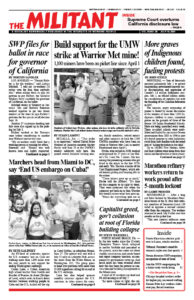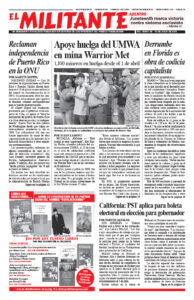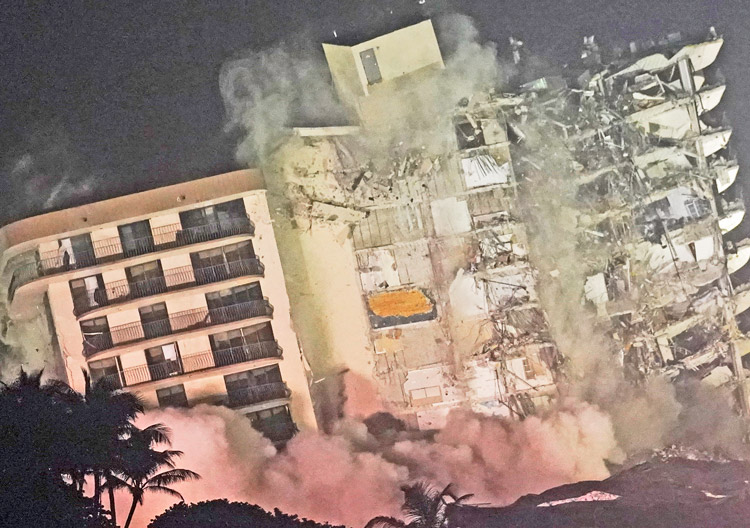NORTH MIAMI BEACH, Fla. — In the two weeks since the 13-story Champlain Towers South collapsed in nearby Surfside and pancaked to the ground, more has come out about shoddy construction and condo board and repair company inaction, accompanied by government cover-up. And much more has been revealed about how this has been the pattern in construction and building management in the Miami area.
A total of 46 residents are dead and 94 still missing as of July 7.
“As more comes to light, the collusion between builders, management and the government is being laid bare,” Anthony Dutrow, Socialist Workers Party candidate for mayor of Miami, told the Militant. “We get a real hearing when we explain that these deaths are the product of the workings of capitalism and its profit-driven rents-and-mortgages system. Working people need to come together and fight for workers control of construction and inspection.”
After the collapse of Champlain Towers, local governments in the area felt compelled to see whether similar catastrophes were lurking in their jurisdictions. Officials here in the city of North Miami Beach turned to review the 10-story Crestview Towers Condominium. For years they had tried and failed to get the management to conduct a mandatory 40-year recertification. When the building’s condo association finally submitted its paperwork last week, it said the 156-unit building was structurally and electrically unsafe for continued habitation. Officials ordered the building evacuated July 2.
“No one knows how many buildings in this area are in danger,” Aracely Colon, a worker at a nearby Walmart store, told this Militant worker-correspondent. “The news that someone has to leave their home after only a few hours’ notice is jarring, but nobody here should really be surprised. While the landlords charge a lot of money here, these places were not well built and are not maintained.”
When Dutrow and campaign supporters knocked on doors here to discuss what working people face, they found many wanted to talk. “I was told by my friend who used to live at Crestview that they were given two hours to take what they could carry and leave forever,” said social worker Rosa Vargas. Her neighbor told the Socialist Workers candidate that he was just glad not to be living there.
The New York Times reports similar problems are widespread. An article, “Lax Enforcement Let South Florida Towers Skirt Inspections for Years,” run July 4, exposes the extent of the crisis. In one city, Key Biscayne, the Times reports, the government decided to call for no extra inspections at all.
The article describes how corners were cut everywhere in a big building boom that saw 57 high-rise buildings go up on barrier islands around Miami between 1970 and 1979, and some 30 more into the late 1980s. Champlain Towers was completed in 1981.
It reports that when the towers were being built, some area developers criticized Surfside city officials for accepting campaign contributions from the owner in exchange for “helping it along.” That owner, Nathan Reiber, had left Canada and later pled guilty to tax evasion there.
Only half the amount of rebar required in the building’s design appears to have been used in the structural columns at its base, reported engineers who visited the site since the collapse.
An inspection report last year at the 19-story Bal Harbour 101 building, less than 2 miles north of where Champlain Towers stood, found serious repairs were needed on the concrete and waterproofing of its pool deck — one of the same key problems in the Surfside building.
The report, which had been due in 2018, also noted significant structural repairs were needed. Then, also as at Champlain Towers, it claimed the overall building structure was in good condition.
Delays, crises and cover-up
Residents at Champlain Towers complained often to friends and family about how the building was run. The condo board was rife with dissention, almost all of its members quitting in the year before the collapse, as needed repairs were continuously put off. While nothing was being done, the building continued to tout its benefits and make sales. Seven units closed in 2021 before the collapse, fetching record prices. Penthouse A sold in May for $2.88 million.
Meanwhile, Surfside government officials helped condo bosses cover up problems and put off critical repairs. When engineers told the Champlain board they had key structural problems on their hands and the building needed a $9.1 million repair, the city’s building official, Rosendo Prieto, told them not to worry, the tower was “in very good shape.”
Then residents felt the building beginning to shake as a new high-rise, called Eighty Seven Park Miami, was going up right next door. “When they were drilling for the piles, Champlain Towers was trembling,” renter Spiros Dimiropoulos said.
Concerned residents contacted Prieto, asking for the town to do something. “There is nothing for me to check,” Prieto responded, suggesting they hire someone else.
“The building is falling apart,” condo board member Marcelo Pena wrote in an Oct. 23 letter of resignation. “Someone can seriously be injured or killed with the state of the concrete.”
The board finally hired Morabito Consultants, which had given them a report outlining the serious problems with the building in 2018, to do the repairs, now estimated to cost $15 million. Morabito’s bid was the most expensive of any they had received.
After even more delays, by both the board and the city, the board finally submitted documents indicating the scope of needed repairs June 21, three days before the building collapsed.
Working-class solidarity
After the collapse, working-class solidarity came fast. “Neighbors brought blankets and robes. A case of water appeared; over the course of the day, dozens more were dropped off,” the Washington Post reported. “Workers from a local bakery walked around with boxes of Kosher croissants, offering them to worried and exhausted people sitting on benches and curbs. A woman with a basket of fruit handed out bananas and apples to anybody who wanted one. Later in the day, local pizzerias delivered dozens of pies. Staff from nearby restaurants passed around sacks full of arepas and croquetas.
“Neighbors loaded up strollers with toys and coloring books from their homes and walked them over to keep the few children there occupied.”
“The only ones who acted in a timely way were those who brought solidarity,” Dutrow said. “This is the future — a mass working-class movements to fight to get rid of the capitalist ruling families and their government at every level and to build a new kind of society. That requires a socialist revolution.”


